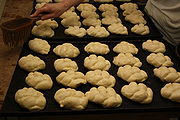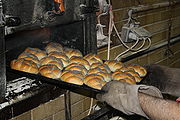Bread roll
This article has multiple issues. Please help improve it or discuss these issues on the talk page. (Learn how and when to remove these template messages)
|
 Bread rolls (lower bin) at a bakery | |
| Type | Bread |
|---|---|
| Course | Side dish |


A roll is a small, often round loaf of bread served as a meal accompaniment (eaten plain or with butter). A roll can be served and eaten whole or cut transversely and dressed with filling between the two halves. Rolls are also commonly used to make sandwiches similar to those produced using slices of bread. It is commonly confused with a mini baguette.
Europe
Rolls are common in Europe, especially in Germany, Italy (where they are called panino or panini) and Austria. They are equally common in both Australia and New Zealand, and very common in Canada and Brazil. Just like English, the German language has many local and dialectal terms for rolls, such as Brötchen (Rhineland and parts of Northern Germany; non-dialectal high German uses this term too), which is the diminutive of "Brot" (bread), Rundstück (in Hamburg and Schleswig-Holstein),[1] Semmel (Bavaria, most parts of Saxony and Austria, from Latin similia wheat flour, originally from Assyrian samidu white flour; the Hungarian term zsemle derives from the same root), Schrippe (in Berlin and parts of Brandenburg), or Weck (especially in Baden-Württemberg, Franconia and Saarland). In Germany and Austria, there is a large variety of bread rolls, ranging from white rolls made with wheat flour, to dark rolls containing mostly rye flour. Many variants include spices, such as coriander and cumin, nuts; or seeds, such as sesame seeds, poppy seed or sunflower seeds. The Doppelweck or Doppelbrötchen is a type of bread roll originating from the Saarland which consists of two rolls joined together side-by-side before baking.
European types
An Italian form is a small loaf of ciabatta which can be used to make a panino (or panini in plural). In Sweden they are called (frukost) bullar ("breakfast buns") franskbrödbullar and frallor, in Denmark and Norway rundstykker (literally "round pieces") and are comfort food eaten with butter and any kind of topping (marmalade, cheese, ham, salami) for special weekend breakfasts.
Preparation
This section needs expansion. You can help by adding to it. (April 2016) |
Below are the steps in bread roll preparation.
- Bread roll preparation
-
1/9
-
2/9
-
3/9
-
4/9
-
5/9
-
6/9
-
7/9
-
8/9
-
9/9
See also
References
External links
 Media related to Bread rolls at Wikimedia Commons
Media related to Bread rolls at Wikimedia Commons










